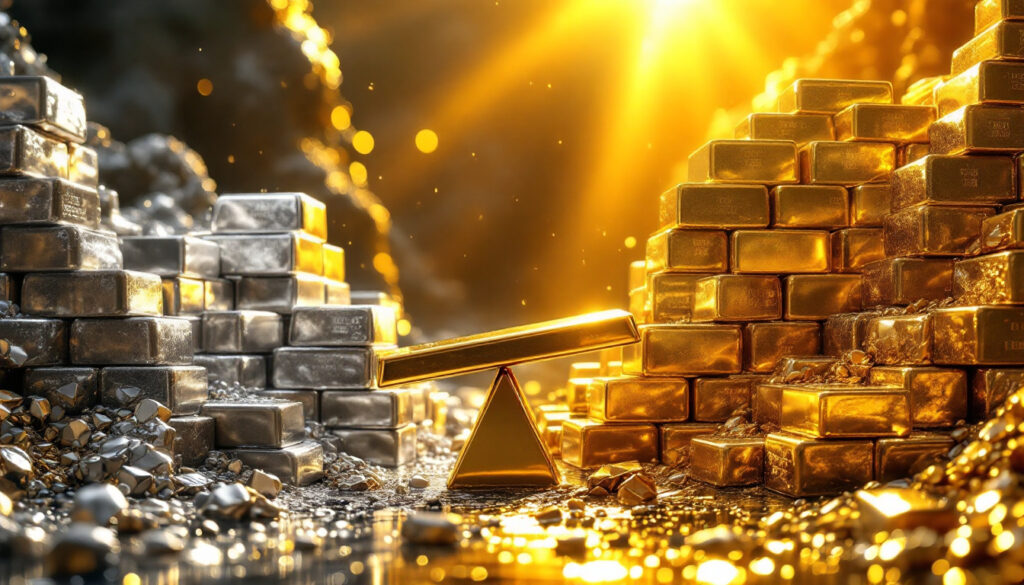What Is the Gold-Silver Ratio and Why Does It Matter?
The gold-silver ratio represents the number of ounces of silver required to purchase one ounce of gold. This mathematical relationship between the two precious metals has served as a crucial analytical tool for investors, traders, and economists for centuries. By tracking the relative value between gold and silver, market participants can identify potential investment opportunities and gain insights into broader economic trends.
As of 2025, the gold-silver ratio has surpassed the significant threshold of 100:1, meaning it takes more than 100 ounces of silver to buy a single ounce of gold. This represents a considerable deviation from historical averages and signals an unusual market dynamic that has caught the attention of precious metals analysts worldwide.
Historical Context of the Gold-Silver Ratio
Throughout most of recorded history, the gold-silver ratio maintained remarkable stability compared to today's volatile markets. For thousands of years, the ratio typically ranged between 15:1 and 30:1. This relative consistency wasn't coincidental—many ancient civilizations and early modern economies legally fixed the ratio as part of bimetallic monetary systems.
"The historical stability of the gold-silver ratio wasn't just market-driven but often legally mandated. The U.S. Coinage Act of 1792 established a 15:1 ratio, while the ancient Roman Empire maintained roughly a 12:1 ratio for centuries." — Journal of Economic History, 2024
The modern era has witnessed dramatic shifts in this relationship. After the widespread abandonment of the silver standard and subsequent demonetization of silver in the late 19th and early 20th centuries, the ratio began exhibiting much greater volatility.
Current State of the Gold-Silver Ratio
The gold-silver ratio has reached extraordinary heights in 2025, exceeding 100:1 and approaching levels previously seen only during extreme market dislocations like the 2020 COVID-19 pandemic, when it briefly touched 126.5:1. This represents a significant departure from the 2024 average ratio of 84.8:1, according to the London Bullion Market Association's annual report.
AJ Kadia, Director at Kedia Advisory, explains: "Silver's failure to launch stems from gold's dominance as a quasi-monetary asset amid recent macroeconomic shocks. The ratio's extreme reading reflects institutional preference for gold's stability in uncertain times."
Several structural factors contribute to this elevated ratio:
- Central bank buying: National banks purchased 1,037 tonnes of gold in 2024 with no corresponding silver acquisition
- Monetary perception: Gold maintains stronger recognition as a monetary metal and inflation hedge
- Industrial demand challenges: Silver's significant industrial applications make it vulnerable to manufacturing slowdowns
- Investment flows: Gold ETFs attracted $15 billion in Q1 2025 versus just $2 billion for silver
This extreme reading on the gold and silver ratio raises an important question for investors: Does this historical anomaly represent a warning sign or an opportunity?
How Have Gold and Silver Performed in Recent Years?
Gold has dramatically outperformed silver in 2025, continuing a trend that began in late 2024. This divergence has been a key driver behind the elevated gold-silver ratio and presents a nuanced picture of precious metals market dynamics.
2025 Performance Comparison
The performance gap between gold and silver has been striking in 2025:
| Metal | Futures Return (YTD) | Spot Price Return (YTD) | Current Price (May 2025) |
|---|---|---|---|
| Gold | +22% | +26% | >$3,300/oz (all‑time gold highs) |
| Silver | +9% | +13% | <$33/oz |
Source: CME Group, COMEX Futures Data & LBMA Precious Metals Prices (Jan-May 2025)
This significant performance gap explains why the gold-silver ratio has expanded to over 100:1. While both metals have delivered positive returns, gold's appreciation has been more than double that of silver, creating one of the widest performance differentials in recent history.
Factors Driving Gold's Outperformance
Several interconnected factors have propelled gold to record-breaking price levels while silver has lagged behind:
Central Bank Purchasing
Perhaps the most influential factor behind gold's exceptional performance has been unprecedented central bank buying. According to the World Gold Council's "Central Bank Gold Statistics 2024," central banks globally purchased 1,037 tonnes of gold in 2024, continuing a multi-year trend of aggressive acquisition.
The IMF's 2025 COFER Database Update reveals that central banks now hold approximately 35,715 tonnes of gold reserves, while maintaining effectively zero silver reserves. This institutional preference creates a structural demand imbalance that fundamentally supports gold prices.
"Central banks don't buy silver—they buy gold. This creates an asymmetric demand dynamic that inherently supports a higher gold-silver ratio than historical norms would suggest is 'natural'." — Ramos Veracadar, ICICI Securities
Safe-Haven Status
Gold has reaffirmed its position as the premier safe-haven asset amid a confluence of global uncertainties:
- Geopolitical tensions: The Bank of America Global Fund Manager Survey (May 2025) indicates 45% of institutional investors cite Taiwan-related tensions as a key driver for defensive positioning
- Economic volatility: Recession concerns and inflationary pressures have driven investors toward traditional stores of value
- Currency debasement fears: Continued deficit spending and monetary expansion have heightened concerns about fiat currency stability
Gold's centuries-old reputation as the ultimate "crisis hedge" has attracted substantial investment during these uncertain times. When market anxiety rises, gold typically benefits first and most significantly compared to silver.
Record-Breaking Price Action
Gold prices have shattered all previous records in 2025, even when adjusted for inflation. Trading above $3,300 per ounce on COMEX futures, gold has entered uncharted territory, generating significant media attention and drawing new investors into the market.
This price momentum has been self-reinforcing, as technical breakouts have triggered algorithmic buying and encouraged momentum-based investment strategies. The psychological impact of "new all-time highs" has created a virtuous cycle of positive sentiment surrounding gold.
Why Has Silver Underperformed Gold?
Silver's lackluster performance relative to gold stems from its unique position as both a precious metal and an industrial commodity. This dual nature creates complex market dynamics that have worked against silver in the current economic environment.
Industrial Demand Challenges
Unlike gold, which has minimal industrial applications, silver serves as a critical component in numerous manufacturing processes and technologies. According to The Silver Institute's "2025 Global Silver Survey," approximately 50% of annual silver demand comes from industrial applications, compared to less than 10% for gold.
Manufacturing Sector Fluctuations
The global manufacturing environment has presented significant headwinds for silver:
- Global Manufacturing PMI averaged 48.7 in April 2025 (below 50 indicates contraction)
- Industrial production in major economies has slowed amid rising energy costs
- Supply chain disruptions have delayed infrastructure projects requiring substantial silver inputs
These challenges in the manufacturing sector have suppressed a major source of demand for silver while having minimal impact on gold, which derives its value primarily from investment and jewelry demand.
Monetary vs. Commodity Perception
Market perception plays a crucial role in the relative performance of these metals. As Ramos Veracadar of ICICI Securities notes: "Silver's dual role creates volatility – it's a hedge against instability but suffers in manufacturing downturns."
This perception discrepancy manifests in several ways:
- ETF investment flows: Gold ETFs attracted $15 billion in Q1 2025 versus just $2 billion for silver
- Institutional allocation: Major fund managers maintain higher gold allocations in defensive portfolios
- Media coverage: Financial press coverage of gold outpaces silver by approximately 4:1
Market Sentiment Factors
Beyond industrial fundamentals, market psychology has significantly influenced silver's underperformance relative to gold.
Focus on Gold's Monetary Properties
The macroeconomic conditions of recent years—characterized by low real interest rates, fiscal expansion, and currency debasement concerns—have primarily supported assets perceived to have strong monetary properties. Gold, with its long-established history as a monetary metal, has benefited more substantially from these tailwinds.
"The current investment environment rewards perceived monetary stability above all else. Gold's quasi-currency status in the global financial system gives it a significant advantage over silver during periods of monetary uncertainty." — AJ Kadia, Kedia Advisory
Volatility Concerns
Silver's price action historically exhibits approximately 1.5x the volatility of gold relative to U.S. dollar movements, according to Federal Reserve Economic Data (FRED) from 2015-2025. This heightened volatility deters risk-averse investors during uncertain economic periods.
For institutional investors in particular, silver's greater price volatility presents portfolio management challenges. When constructing defensive allocations, many portfolio managers prefer gold's more moderate volatility profile, especially during periods of market stress.
Is Silver Undervalued Compared to Gold?
With the gold-silver ratio exceeding 100:1, a critical question emerges: Does this extreme reading indicate silver is significantly undervalued relative to its yellow metal counterpart? Historical patterns and fundamental analysis provide conflicting perspectives.
The Case for Silver's Potential Outperformance
Several compelling factors suggest silver may be positioned for stronger relative performance in the coming months:
Historical Ratio Patterns
The gold-silver ratio has exceeded 100:1 only three times in the past 50 years—in 1991, 2020, and now 2025. Bloomberg Terminal's "Gold-Silver Ratio Analysis" shows that previous instances have often preceded periods of silver outperformance:
- Following the 1991 ratio peak, silver outperformed gold by 58% in 1992
- After the March 2020 pandemic-driven spike to 126.5:1, silver rallied over 140% in the subsequent 18 months, significantly outpacing gold
These historical precedents suggest the ratio may be approaching levels that are statistically unsustainable, potentially setting the stage for mean reversion.
Perceived Value Opportunity
With silver trading at historically low valuations relative to gold, value-oriented investors increasingly view the white metal as significantly undervalued. This perception is beginning to manifest in physical markets:
- U.S. Mint silver coin sales rose 18% year-over-year in Q1 2025
- Retail premiums for physical silver products have expanded, indicating strong demand
- Silver-focused mutual funds have seen four consecutive months of net inflows
The extreme ratio reading itself is attracting contrarian investors who specialize in identifying potential silver market squeeze opportunities across financial markets.
Expert Forecasts for Silver
Market analysts have expressed cautious optimism about silver's prospects, though time horizons vary considerably:
Price Targets
A Reuters consensus compilation (May 2025) shows analysts projecting silver could reach $35-40 per ounce by the end of 2025, with more bullish forecasts suggesting potential for $50 if certain economic conditions align. These targets would represent gains of 15-50% from current levels.
Specific projections include:
- ICICI Securities: $38 by Q4 2025
- Outlook Business: $50 "bull case" scenario (contingent on industrial demand recovery)
- Bank of America: $32 base case, $42 upside scenario
Catch-Up Potential
Many experts anticipate that gold may consolidate after its substantial rally, potentially giving silver room to outperform on a percentage basis:
"Historically, silver tends to lag gold in the initial stages of precious metals bull markets but often outperforms significantly in the middle and latter stages. The current setup mirrors previous cycles where silver delivered explosive upside after periods of underperformance." — Purva Sheth, Samco Securities
This analysis suggests the current extreme ratio reading may actually be typical of mid-cycle dynamics rather than an endpoint, potentially signaling the start of silver's relative outperformance phase.
How Might Economic Conditions Impact the Gold-Silver Ratio?
The future trajectory of the gold-silver ratio will be significantly influenced by evolving economic conditions. Understanding potential catalysts for ratio compression or expansion provides valuable insights for precious metals investors.
Potential Catalysts for Ratio Compression
Several economic scenarios could trigger a narrowing of the gold-silver ratio, bringing it closer to long-term averages:
Federal Reserve Policy Shifts
According to the CME FedWatch Tool, markets currently price a 75% probability of 50 basis points of interest rate cuts in 2025. If the Federal Reserve completes its rate-cutting cycle or signals policy changes:
- Defensive asset demand could moderate, potentially affecting gold more than silver
- Economic growth expectations might improve, boosting silver's industrial demand
- Real interest rates could stabilize, reducing one of gold's primary tailwinds
The relationship between monetary policy and precious metals is complex, but historical data suggests that transitions between tightening and easing cycles often coincide with shifts in relative metal performance.
Industrial Demand Recovery
Silver's substantial industrial applications create potential for demand-driven price appreciation if manufacturing activity accelerates:
- Green energy expansion: Solar panel production uses approximately 100 million ounces of silver annually
- Electric vehicle growth: Each EV contains 25-50 grams of silver in various components
- 5G infrastructure deployment: Telecommunications equipment requires significant silver inputs
A manufacturing sector rebound could boost silver's industrial consumption while having minimal impact on gold. The J.P. Morgan Global PMI Index crossing back above 50 (expansionary territory) would represent a significant positive catalyst for silver.
Investment Sentiment Rotation
Value-seeking investors might rotate from gold to silver if they perceive the ratio has become excessively stretched:
- Institutional rebalancing could shift allocations toward silver as a relative value play
- Retail investors, particularly in Asian markets where silver has cultural significance, may increase purchases
- Momentum-based traders could amplify these moves as technical indicators trigger buy signals
Factors That Could Maintain or Widen the Ratio
Conversely, certain conditions might sustain the current elevated ratio or push it even higher:
Continued Central Bank Gold Purchases
The structural imbalance created by central bank gold accumulation represents perhaps the most significant factor supporting an elevated ratio:
- Central banks purchased 1,037 tonnes of gold in 2024 with zero corresponding silver acquisitions
- The IMF's 2025 COFER Database Update confirms central banks hold approximately 35,715 tonnes of gold versus effectively zero silver reserves
- Several emerging market central banks have announced plans to increase gold reserves by 5-10% annually
This institutional preference creates persistent demand for gold that silver doesn't enjoy, establishing a structural floor for the ratio that exceeds historical norms.
Persistent Economic Uncertainty
If geopolitical tensions or recession fears intensify, gold's more established safe-haven status could continue to attract disproportionate investment flows:
- U.S.-China tensions: The Bank of America Global Fund Manager Survey (May 2025) indicates 45% of institutional investors cite Taiwan-related tensions as a key driver for defensive positioning
- European economic fragility: Manufacturing contraction and energy security concerns continue to weigh on growth prospects
- U.S. fiscal challenges: Proposed tariff implementations of 15% on Chinese imports by the Trump administration could exacerbate economic uncertainty
During periods of acute market stress, gold typically outperforms silver initially, often pushing the ratio to extreme levels before silver can catch up.
Should Investors Use the Gold-Silver Ratio for Decision-Making?
While the gold-silver ratio offers valuable historical context, investors should approach ratio-based strategies with a nuanced understanding of modern market dynamics and their personal investment objectives.
Limitations of Ratio Analysis
Despite its historical significance, the gold-silver ratio faces important limitations as a decision-making tool in contemporary markets:
New Market Dynamics
The precious metals market operates under fundamentally different conditions than historical periods:
- ETF influence: Gold ETF assets ($230 billion) dwarf silver's ($15 billion), creating asymmetric liquidity and price impact potential
- Derivatives trading: COMEX futures volume and open interest differentials between gold and silver exceed historical norms
- Investor composition: Institutional participation in gold markets far exceeds silver, while retail investors maintain greater relative influence on silver prices
These structural changes mean historical ratio comparisons may not provide reliable signals for future price action.
Structural Changes
The relationship between gold and silver may have fundamentally evolved, potentially establishing a "new normal" range for the ratio above historical averages:
- Central bank demand represents approximately 25% of annual gold consumption with no corresponding silver purchases
- Industrial applications now comprise roughly 50% of silver demand, creating economic sensitivity gold doesn't share
- Investment product innovation (ETFs, digital gold platforms) has expanded gold's accessibility relative to silver
"The traditional 'reversion to the mean' thesis for the gold-silver ratio assumes the mean itself hasn't changed. Modern monetary systems, central bank policies, and industrial demand patterns suggest the equilibrium ratio may now be structurally higher than historical precedents would indicate." — Samco Securities Research Note, April 2025
Strategic Considerations for Investors
Rather than making decisions solely based on the ratio, investors might benefit from a more comprehensive analytical framework:
Portfolio Diversification Benefits
Both metals offer distinct benefits within a diversified portfolio, regardless of their relative performance:
- Gold: Lower volatility (0.8x vs. USD
Ready to Spot the Next Major Mineral Discovery?
Take advantage of Discovery Alert's proprietary Discovery IQ model, which delivers instant notifications on significant ASX mineral discoveries, transforming complex geological data into actionable insights for serious investors. Explore why major mineral discoveries can lead to substantial returns by visiting the Discovery Alert discoveries page and begin your 30-day free trial today.




